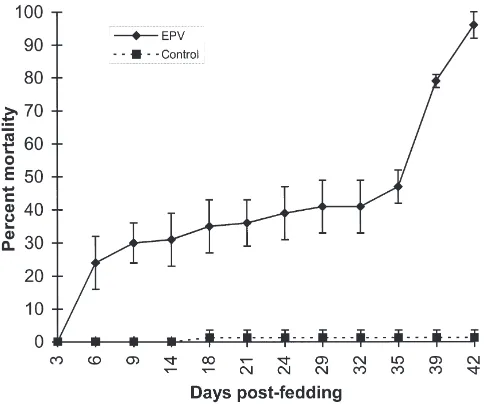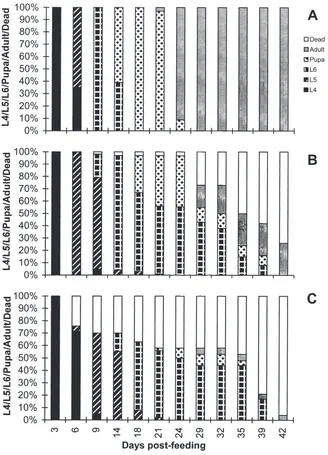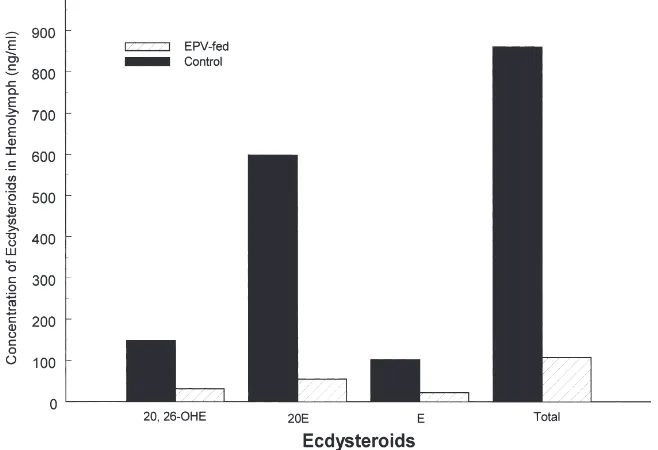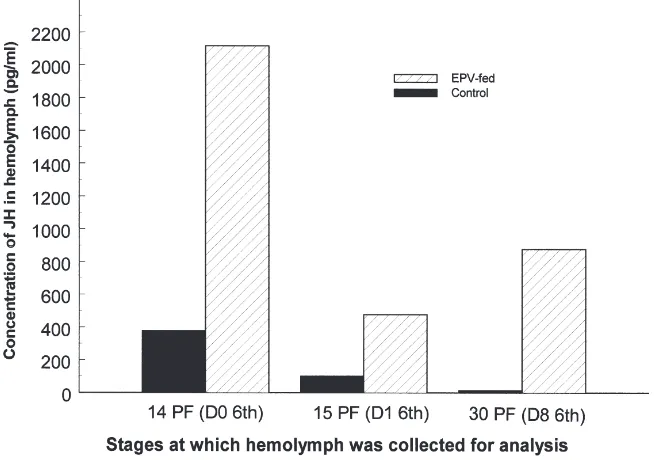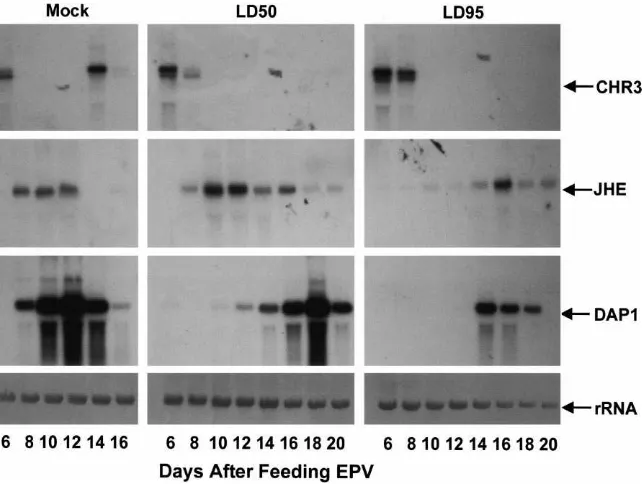www.elsevier.com/locate/ibmb
Choristoneura fumiferana entomopoxvirus prevents metamorphosis
and modulates juvenile hormone and ecdysteroid titers
S.R. Palli
a,*, T.R. Ladd
a, W.L. Tomkins
a, S. Shu
b, S.B. Ramaswamy
b, Y. Tanaka
c,
B. Arif
a, A. Retnakaran
aaGreat Lakes Forestry Centre, Canadian Forest Service, Sault Ste. Marie, Ont. P6A 5M7, Canada bDepartment of Entomology, Kansas Sate University, Manhattan, KS 66506, USA
cNational Institute of Sericultural and Entomological Sciences, Tsukuba, Japan
Received 31 October 1999; received in revised form 31 December 1999; accepted 25 January 2000
Abstract
Larvae of the spruce budworm, Choristoneura fumiferana, infected with C. fumiferana entomopoxvirus (CfEPV) continue to feed and grow without undergoing metamorphosis and die as moribund larvae. The lethal dose (LD50) and lethal time (LT50) values
for fourth instar larvae are 2.4 spheroids and 25.2 days, respectively. One hundred percent of the control fourth instar larvae, which were fed water instead of virus, pupated by 18 days post feeding (PF). Only 30% of the larvae that were fed the LD50dose and
none of the larvae that were fed the LD95dose pupated by 18 days PF. Of the control larvae, 95% became adults by 24 days PF,
whereas in the treated group only 2% of larvae that were fed the LD50dose and none of the larvae that were fed the LD95dose
became adults by 24 days PF. Some of the virus-treated larvae died as either larval/pupal or pupal/adult intermediates. These phenotypic effects were similar to the larval/pupal and pupal/adult intermediates, resulting from treating larvae with juvenile hormone (JH) or its analogs, which suggests that EPV may cause such abnormalities by modulating JH and/or ecdysteroid titers. In untreated sixth instar larvae the JH titer decreased to low levels by 24 h after ecdysis and remained low throughout larval life. EPV-fed sixth instar larvae had 2112 pg/ml on day 0, 477 pg/ml on day 1 and 875 pg/ml on day 8 of the sixth instar. Control larvae contained 860 ng of ecdysteroids per ml hemolymph on day 8 of the sixth instar, whereas EPV-treated larvae of the same age (30 days PF) had only 107 ng of ecdysteroids per ml of hemolymph. Thus, EPV infection results in increased JH titer and decreased ecdysteroid titer. Northern hybridization analysis was performed using RNA isolated from control and EPV-fed larvae and cDNA probes for (i) juvenile hormone esterase (JHE), which is JH inducible, (ii) Choristoneura hormone receptor 3 (CHR3), which is ecdysteroid inducible, and (iii) larval specific diapause associated protein 1 (DAP1), whose expression is larval specific. EPV-treated larvae showed higher levels of JHE and DAP1 mRNA and lower levels of CHR3 mRNA, indicating that they had higher levels of JH and lower levels of ecdysteroids. Thus, our data show that EPV prevents metamorphosis by modulating ecdysteroid and JH levels.
2000 Elsevier Science Ltd. All rights reserved.
Keywords: Insect control; Insect viruses; Metamorphosis; Juvenile hormone esterase; Choristoneura hormone receptor 3; Diapause associated
proteins
1. Introduction
Owing to problems associated with chemical insecti-cides, biological control of insect pests has become increasingly important in recent years. Traditional bio-logical control agents such as parasites and predators are
* Corresponding author. Tel.:+1-705-759-5740; fax:+ 1-705-759-5700.
E-mail address: [email protected] (S.R. Palli).
0965-1748/00/$ - see front matter2000 Elsevier Science Ltd. All rights reserved. PII: S 0 9 6 5 - 1 7 4 8 ( 0 0 ) 0 0 0 6 0 - 6
eco-logically attractive alternatives to chemical pesticides (Palli and Retnakaran, 1998).
The spruce budworm, Choristoneura fumiferana, is a devastating pest of coniferous forests in North America and several different control methods are being developed to manage this insect. Insect viruses such as nucleopolyhedrovirus, cypovirus, and entomopoxvirus that cause diseases in the spruce budworm are especially attractive because they have little or no negative impact on the environment. Understanding the biology and pathology as well as effect of these viruses on insect physiology will help to improve these viruses as biologi-cal control agents. The studies presented in this paper are performed to understand the effect of entomopox-viruses on the physiology of the spruce budworm. The entomopoxviruses (EPV) belong to the subfamily of Entomopoxvirinae (insect poxviruses) and the entomo-poxvirus that infects C. fumiferana (C. fumiferana ento-mopoxvirus, CfEPV) is placed in Genus B of Lepidop-tera and OrthopLepidop-tera; Amsacta moorei EPV is the type species for this genus.
CfEPV, first discovered in the 2-year cycle spruce budworm, C. biennis, also infects C. fumiferana (Bird et al., 1971). The EPV infection is generally initiated by ingestion of occlusion bodies (OB), which are dissolved in the alkaline environment of the gut, thereby releasing the virions. The virions then enter the epithelial cells of the gut and spread throughout the body, but the fat body appears to be the major site of replication for this virus. Several studies on entomopoxvirus pathology and mol-ecular biology have been described in the literature (Arif, 1995 and references therein).
Preliminary experiments showed that larvae infected with CfEPV exhibited normal development until the last instar stage when, despite feeding and growing, the lar-vae did not undergo molt or metamorphosis. Death occurred at the last larval stage, but as infected larvae continue to feed, CfEPV may not be a good pest control agent. However, if we understand the infection process of CfEPV and the effects on its host, it is possible to modify the virus to induce early cessation of feeding or cause early death of the infected insect. The genome of CfEPV can also be a source of genes with properties useful in designing biorational pest control agents.
The main objective of the current study was to explain the effects of EPV on the endocrinology of C. fumifer-ana, and to determine the possible reasons for the con-tinuation of the larval–larval molt and prevention of lar-val–pupal metamorphosis. In this report we present evidence to show that EPV infection blocks both larval– pupal metamorphosis and modulates juvenile hormone (JH) and 20-hydroxyecdysone (20E) titers.
2. Materials and methods
2.1. Animals
Choristoneura fumiferana larvae were reared on an artificial diet, as described in Grisdale (1970).
2.2. EPV preparation, feeding and assessment of its effects on development and survival
A stock of CfEPV available at the Great Lakes For-estry Centre, Canadian Forest Service, was amplified by infecting post-diapause C. fumiferana second instar lar-vae and harvested by homogenizing infected large sixth instar larvae in 0.1% SDS and occlusion bodies (OB) were isolated and washed by centrifugation. The concen-tration of OB was determined in a hemocytometer.
To determine the LD50and LT50values, fourth instar
larvae were fed various doses of CfEPV by spreading OB in water on a small diet plug. Only larvae that con-sumed the entire diet plug in 1 h were included in the analysis. A minimum of three replicates (25 larvae per replicate) were included for each treatment. The mor-tality and time to death were recorded. The LD50 and
LT50 values were determined using the Polo probit
analysis program (Russell et al., 1977). To determine the effect of EPV on insect development, fourth instar C. fumiferana larvae were fed diet plugs containing LD50
or LD95doses of CfEPV OB. At various time points post
feeding (PF) the developmental stage of the insect was determined. Three replicates of 25 larvae for each repli-cate were used for these experiments as well. In both experiments, control larvae were reared on diet treated with water, the solvent for viral solutions.
2.3. Determination of ecdysteroid and juvenile hormone titers
Hemolymph from EPV- and water-fed larvae was col-lected on various days PF. For each sample data hemo-lymph from 20–100 larvae were pooled. For juvenile hormone analysis samples were immediately dispensed into a glass vial containing a mixture of acetonitrile/2% NaCl (650µl/750µl). An internal standard, JH-III ethyl ester, was added to each vial (100 pg/100 µl), and the samples were stored at 220°C until analysis. JH titers
were determined as described by Shu et al. (1997) and the recovery of standard was 90–94%. Hemolymph
ecdysteroids in hemolymph were analyzed using
2.4. mRNA isolation and Northern hybridization
Total RNA was isolated from water- and EPV-fed lar-vae using the guanidine isothiocyanate–phenol–chloro-form extraction method (Chomczyski and Sacchi, 1987). RNA concentrations were determined spectrophotometr-ically and stained by adding 1 mg of ethidium bromide
to the sample. Ten micrograms of total RNA was denatured and separated on a 1.0%
agarose–formal-dehyde gel, transferred to Hybond N-membrane
(Amersham Life Science Inc., Oakville, Ont., Canada), and linked to the membrane using a UV cross-linker (Stratagene Cloning Systems, LaJolla, CA).
Previous studies in our laboratory showed that Choris-toneura hormone receptor 3 (CHR3) mRNA levels can serve as a reliable indicator of ecdysteroid level, as this gene is expressed only in the presence of ecdysteroids (Palli et al., 1996). Studies on C. fumiferana juvenile hormone esterase (CfJHE) showed that CfJHE mRNA level increases in the presence of JH and decreases in the presence of 20E (Feng et al., 1999). The diapause associated protein 1 (DAP1) identified in C. fumiferana is a larval specific protein and its mRNA level decreases at metamorphosis in the presence of 20E and absence of JH (Palli et al., 1998). We used cDNA probes for these three genes and analyzed their mRNA levels in water-and EPV-fed larvae to corroborate our results on ecdys-teroid and JH titer measurements. cDNA inserts were isolated and random prime labeled with [32
P], and used to probe the RNA blots. Pre-hybridization, hybridization and washes were performed as described in Palli et al. (1998).
3. Results
3.1. Determination of LD50and LT50
The LD50and LT50of CfEPV for fourth instar C.
fum-iferana larvae were estimated as 2.4 OB and 25.2 days, respectively. About 24% of the EPV-fed fourth instar larvae died within 6 days PF, and the mortality rate increased to 30% by 9 days PF (Fig. 1). The rate of mortality then slowed down and reached 40% by 35 days PF. However, there was a steep rise in mortality from 35 days PF and it reached 100% by 42 days PF. Larvae that died before 9 days PF did not contain detectable levels of OB, while those dying after 35 days PF con-tained large quantities. It appears, therefore, that the OB fed to these larvae probably contained some toxic subst-ance that caused the initial 30% mortality that occurred by 9 days PF. However, virus replication and pathogen-esis are necessary to cause mortality above 30%, and these events take place only after 9 days PF.
Fig. 1. Mortality curves of control (water-fed) and EPV-fed
Choris-toneura fumiferana larvae. Fourth instar C. fumiferana larvae (three
replicates of 25 larvae per replicate) were fed on a LD95 dose of
CfEPV. The larvae were scored on days 3, 6, 9, 14, 21, 24, 32, 35, 39, and 42 days post feeding. The means of the three replicates±SD are shown.
3.2. Effect of EPV on C. fumiferana development
Comparative development of water-fed control and EPV-fed (LD50and LD95doses) C. fumiferana larvae is
shown in Fig. 2. Control larvae developed normally and molted into fifth instar by 3 days PF, sixth instar by 9 days PF, pupae by 18 days PF, and adults by 29 days PF. The development was slowed down in EPV-fed lar-vae. None of the fourth instar larvae that fed on either LD50 or LD95 OB molted into fifth instar larvae by 3
days PF. However, all of the fourth instar larvae fed on LD50 OB molted into fifth instar larvae by 6 days PF
and molted into sixth instar larvae by 14 days PF. Fifty percent of LD50 OB fed larvae pupated by 21 days PF,
and 50% of them became adults by 35 days PF (Fig. 2). Ten percent of the larvae died during larval–pupal metamorphosis and an additional 60% died during pupal adult metamorphosis (Fig. 2). About 30% of fourth instar larvae fed an LD95dose of OB died as fourth instar
lar-vae and the rest molted into fifth instar larlar-vae by 9 days PF and sixth instar larvae by 18 days PF (Fig. 2). These larvae continue to feed and grow but remained as sixth instar larvae for about 3 weeks, and eventually died (Fig. 2). At the higher dose of EPV, the larvae continued to feed, grow, and molt until they reached the sixth instar stage, but failed to undergo metamorphosis into pupae and died as large larvae.
A small number (about 10%) of the CfEPV larvae treated with either a LD50 or LD95 dose of OB died as
Fig. 2. Comparative development of control (A; water-fed) and EPV-fed (B; LD50dose and C; LD95dose) C. fumiferana larvae. Seventy-five
fourth instar C. fumiferana larvae (three replicates of 25 larvae per replicate) were fed water (A), or the LD50(B), or LD95(C) dose of CfEPV.
On days 3, 6, 9, 14, 18, 21, 24, 29, 32, 35, 39, or 42 post feeding, the percent mortality and the developmental stage that the surviving larvae had reached (L4, L5, L6, pupa, or adult) were determined. At each observation point, the percent mortality and the developmental stage of survivors are shown in stacked bars.
wings and antennae, as well as problems in shedding the larval integument, were some of the more common effects. Some of these effects are similar to the morpho-logical effects caused by hormonal imbalance, especially high levels of JH in the last larval instar. This prompted us to measure the ecdysteroid and JH levels in EPV-fed larvae.
3.3. Effect of EPV on ecdysteroid titers
In the first experiment hemolymph was collected from EPV-fed large sixth instar larvae at 30 days PF (these
Fig. 3. Juvenile hormone and ecdysteroid titers in the hemolymph of fifth and sixth instar Choristoneura fumiferana larvae. Hemolymph was collected at 12 h intervals throughout the fifth and sixth instar and the concentration of JH was measured as described by Shu et al. (1997). At each time point, hemolymph was collected from 20–100 larvae and pooled for analysis. Total JH (JHI, JHII and JHIII) concentrations in pg/ml of hemolymph are shown. Ecdysteroid titer shown is from Palli et al. (1995).
of 20,26-OHE, 20E, and E were measured. Hemolymph of control sixth instar larvae contained 148 ng/ml 20,26-OHE, 598 ng/ml 20E, 102 ng/ml E, for a total of 861 ng of total ecdysteroids per ml of hemolymph (Fig. 4). In contrast, EPV-fed larvae had only 31 ng/ml of 20,26-OHE, 54 ng/ml of 20E and 22 ng/ml of E for a total of 107 ng/ml of total ecdysteroids (Fig. 4). There was at least a nine-fold difference in the level of total ecdys-teroids between controls and treated larvae.
Fig. 4. Comparison of ecdysteroid levels in control and EPV-fed C. fumiferana larvae. Hemolymph was collected from several one hundred water-fed (controls) or CfEPV-fed C. fumiferana larvae and the concentrations of E, 20,26-OHE, and 20E were determined by the HPLC method described by Tanaka (1995).
3.4. Effect of EPV on JH titers
concentrations were also measured in control (water-fed) and treated (EPV-fed) larvae in two independent experi-ments, each time using pooled hemolymph from 20–100 larvae collected at 14 days PF, 15 days PF and 30 days PF. The EPV-fed larvae were also staged based on developmental age; a large number of larvae were EPV-fed and the larvae that molted into sixth instar on the 14th day PF were used for collection of hemolymph on days 0 and 1 of the sixth instar stage. As explained above, 30 day PF larvae were at the end of the sixth larval stage. Hemolymph from control sixth instar larvae was collected on days 0, 1 and 8 after molting. In the control larvae, about 380 pg of JHs/ml of hemolymph were detected at the time they molted into sixth instars, which decreased to 100 pg/ml by 24 h after molting and 14 pg/ml by 8 days after molting into sixth instar larvae (Fig. 5). In the EPV-fed larvae, 2117 pg of JHs/ml of hemolymph were detected at the time of molting into sixth instar larvae, which decreased to 477 pg/ml by 24 h after molting and 878 pg/ml by the end of the sixth instar (Fig. 5). Thus, JH levels were higher in treated larvae than in control larvae.
3.5. Effect of EPV on CHR3, CfJHE and DAP1 mRNA levels
Mock-treated (water fed) larvae showed CHR3 mRNA on the 6th and 14th days PF, indicating the pres-ence of ecdysteroid peaks during the sixth larval molt and pupal metamorphosis, respectively. Larvae fed either LD50 or LD95 dose of EPV–OB showed CHR3
mRNA only during the sixth larval molt but not
there-Fig. 5. Comparison of JH levels in control and EPV-fed C. fumiferana. Hemolymph was collected from water-fed or CfEPV-fed C. fumiferana larvae and the concentration of JH in the hemolymph was determined as described by Shu et al. (1997). Means from two independent experiments using pooled hemolymph from 20–100 larvae for each time point are shown.
after, indicating that after the sixth larval molt 20E levels did not increase (Fig. 6). In the water fed controls, the CfJHE mRNA was only detected between 8 and 12 days PF, whereas in EPV-fed larvae, CfJHE mRNA was detected beginning on 8 days PF and remained detect-able until 20 days PF (Fig. 6). Control larvae showed DAP1 mRNA beginning on 8 days PF, which then decreased to low levels by 16 days PF. In contrast, in larvae fed the LD50dose of OB, the DAP1 mRNAs were
detectable by 10 days PF and remained high until 20 days PF. In larvae fed with an LD95 dose of OB, the
DAP1 mRNA were detected by 14 days PF and then decreased to undetectable levels by 20 days PF. Both CfJHE and DAP1 mRNA analyses indicated higher JH and lower ecdysteroid levels in EPV-fed larvae, in accordance with our hormonal measurements.
4. Discussion
lev-Fig. 6. Northern hybridization analyses of CHR3, CfJHE and DAP1 mRNAs in C. fumiferana larvae fed water (control), or the LD50dose or
LD95dose of CfEPV (treatments). Three larvae were collected on days 6, 8, 10, 12, 14, 16, 18, and 20 post feeding. The total RNA from the
larval samples was isolated and resolved on a 1% agarose–formaldehyde gel, transferred to Hybond-N membrane and probed with CHR3 or CfJHE or DAP1 cDNAs labeled with32P-dATP.
els in infected and uninfected larvae were in accordance with the hormone titer results.
Whether CfEPV is influencing both JH and ecdys-teroid titers or it is modulating only one of them, and that in turn is altering the level of the other, is unclear from these data. Reduced 20E titers could be due to a decrease in the synthesis and secretion of ecdysteroids by infected prothoracic glands (PG) or to rapid metab-olism of ecdysteroids in the hemolymph. The HPLC method used for measuring ecdysteroid titers can detect most of the free but not conjugated ecdysteroids. Baculo-viruses such as nucleopolyhedrovirus, Autographa cali-fornica nucleopoyhedrovirus (AcMNPV), prolong larval life of infected insects by reducing the 20E titer. This is achieved by using an enzyme, coded by AcMNPV, ecdysteroid UDP-glucosyl transferase (egt), that cata-lyzes the transfer of glucose from UDP-glucose to ecdys-teroids and the conjugated hormone is then cleared (O’Reilly and Miller, 1989). We did not find any egt in CfEPV-infected C. fumiferana larvae. Neither did we notice any major increase in ecdysteroid metabolites in the EPV-infected larvae. These findings suggest that reduction in ecdysteroid titers is most likely due to reduced synthesis and secretion rather than increased metabolism. This reduction could be the result of infec-tion of the PG by CfEPV or as a consequence of elevated JH titers in CfEPV infected larvae, which in turn can inhibit release of PTTH and control ecdysteroid secretion (Sakurai and Imokawa, 1988).
In general, ecdysteroid concentrations required for
lar-val–larval molt are lower than ecdysteroid concen-trations required for larval–pupal metamorphosis.(Fig. 3; Palli et al., 1995). Therefore, it is likely that the lower concentrations of ecdysteroids present in infected larvae are sufficient for larval–larval molt but not for larval– pupal metamorphosis, thus preventing the last larval instar from molting. One could also argue that the EPV infected larvae died at the end of larval life because that is how long it takes for EPV to replicate and cause death. But, regardless of the stage at which the larvae were infected, most of the larvae died as large, last instar lar-vae. Thus, the observed symptoms could be due to an interactive effect between hormonal imbalance and virus-induced pathology.
In the last instar C. fumiferana larvae there are two ecdysteroid peaks, the initial small peak is equivalent to the commitment peak in Manduca sexta (Curtis et al., 1984; Riddiford, 1976) and the latter one is the molt-inducing prepupal peak (Palli et al., 1995; Fig. 3). The JH level starts off high at the beginning of the last larval instar but very quickly decreases to low levels (Fig. 3), and it remains low during the commitment peak of ecdy-steroids. If JH analogs are administered at the early stage of the sixth instar prior to the commitment ecdysteroid peak, the larva does not metamorphose into a pupa but molts into a supernumerary larva (Retnakaran, 1973). The high level of JH present in the EPV-infected larvae at this stage likely prevents metamorphosis.
metabolism by decreasing the production or activity of JH metabolizing enzymes such as JHE. Northern hybridization results showed that JHE mRNA levels were higher in EPV-infected larvae but since JH levels in the hemolymph were higher than in the controls, the block was probably not at the transcriptional level. Since the virus infecting the fat body cells is utilizing the cellu-lar machinery for producing viral proteins it is likely that the JHE mRNA builds up without being translated and/or degraded. This would explain the high concomi-tant occurrence of JH titer as well as JHE mRNA. The process by which EPV-fed larvae maintain higher JH titers requires further study.
Acknowledgements
This research was supported by the Canadian Forest Service and the National Biotechnology Strategy Fund and by CSREES Agreement No. 98-35302-6985. We thank Karen Jamieson for editorial help. This is paper number 00-99-J, Kansas State University Agricultural Experimental Station and Cooperative Extension Ser-vice.
References
Arif, B.M., 1995. Recent advances in the molecular biology of entomo-poxviruses. J. Gen. Virol. 76, 1–13.
Bird, F.T., Sanders, C.J., Burke, J.M., 1971. A newly discovered virus disease of the spruce budworm Choristoneura biennis
(Lepidoptera: Tortricidae). J. Invert. Pathol. 18, 159–161. Chomczyski, P., Sacchi, N., 1987. Single-step method of RNA
iso-lation by acid guanidiniumthiocyanate phenol–chloroform extrac-tion. Anal. Biochem. 162, 156–159.
Curtis, A.T., Hori, M., Green, J.M., Wolfgang, W.J., Hiruma, K., Rid-diford, L.M., 1984. Ecdysteroid regulation of the onset of cuticular melanization in allatectomized and black, mutant Manduca sexta larvae. J. Insect Physiol. 30, 597–606.
Feng, Q., Ladd, T.R., Tomkins, W.L., Sundaram, M., Sohi, S.S., Retnakaran, A., Davey, K.G., Palli, S.R., 1999. Spruce budworm
Choristoneura fumiferana juvenile hormone esterase: hormonal
regulation, developmental expression and cDNA cloning. Mol. Cell. Endocrinol. 148, 95–108.
Grisdale, D., 1970. An improved laboratory method for rearing large numbers of spruce budworm Choristoneura fumiferana
(Lepidoptera:Tortricidae). Can. Entomol. 102, 1111–1117. O’Reilly, D.R., Miller, L.K., 1989. A baculovirus blocks insect molting
by producing ecdysteroid UDP-glucosyl transferase. Science 245, 1110–1112.
Palli, S.R., Primavera, M., Lambert, D., Retnakaran, A., 1995. Age specific effects of 5992: a non-steroidal ecdysone agonist, RH-5992, on the spruce budworm Choristoneura fumiferana
(Lepidoptera: Tortricidae). Eur. J. Entomol. 92, 325–332. Palli, S.R., Ladd, T.R., Sohi, S.S., Cook, B.J., Retnakaran, A., 1996.
Cloning and developmental expression of Choristineura hormone receptor 3, an ecdysone inducible gene and a member of the steroid hormone receptor superfamily. Insect Biochem. Mol. Biol. 26, 485–499.
Palli, S.R., Ladd, T.R., Ricci, A.R., Primavera, M., Mungrue, I.N., Pang, A.S.D., Retnakaran, A., 1998. Identification, purification, cDNA cloning and developmental expression of mRNA for two proteins that are produced prior to diapause and pupation in the spruce budworm, Choristoneura fumiferana. J. Insect Physiol. 44, 509–524.
Palli, S.R., Retnakaran, A., 1998. Biological control of forest pests: A biotechnological perspective. In: Bruce, A., Palfreyman, A.W. (Eds.) A Forest Products Biotechnology. Taylor and Francis, Lon-don, pp. 267–286.
Retnakaran, A., 1973. Hormonal induction of supernumerary instars in the spruce budworm Choristoneura fumiferana (Lepidoptera: Tortricidae). Can. Entomol. 105, 459–461.
Retnakaran, A., Bird, F.T., 1972. Apparent hormone imbalance syn-drome caused by an insect virus. J. Invert. Pathol. 20, 358–360. Riddiford, L.M., 1976. Hormonal control of insect epidermal cell
com-mitment in vitro. Nature 259, 115–117.
Russell, R.M., Robertson, J.L., Savin, N.E., 1977. POLO: A new com-puter program for probit analysis. ESA Bull. 23, 209–212. Sakurai, S., Imokawa, H., 1988. Developmental arrest induced by
juv-enile hormone titers in pupal and adult stages of southwestern corn borer [Diatraea grandiosella (Pyralidae)] and its relationship with egg development. J. Insect Physiol. 43, 719–726.
Shu, S., Park, Y.I., Ramaswamy, S.B., Srinivasan, A., 1997. Hemo-lymph juvenile hormone titers in pupal and adult stages of south-western corn borer [Diatraea grandiosella (Pyralidae)] and its relationship with egg development. J. Insect Physiol. 43, 719–726. Tanaka, Y., 1995. The different effects of ecdysone and 20-hydroxyec-dysone on the induction of larval ecdysis in the silkworm, Bombyx
